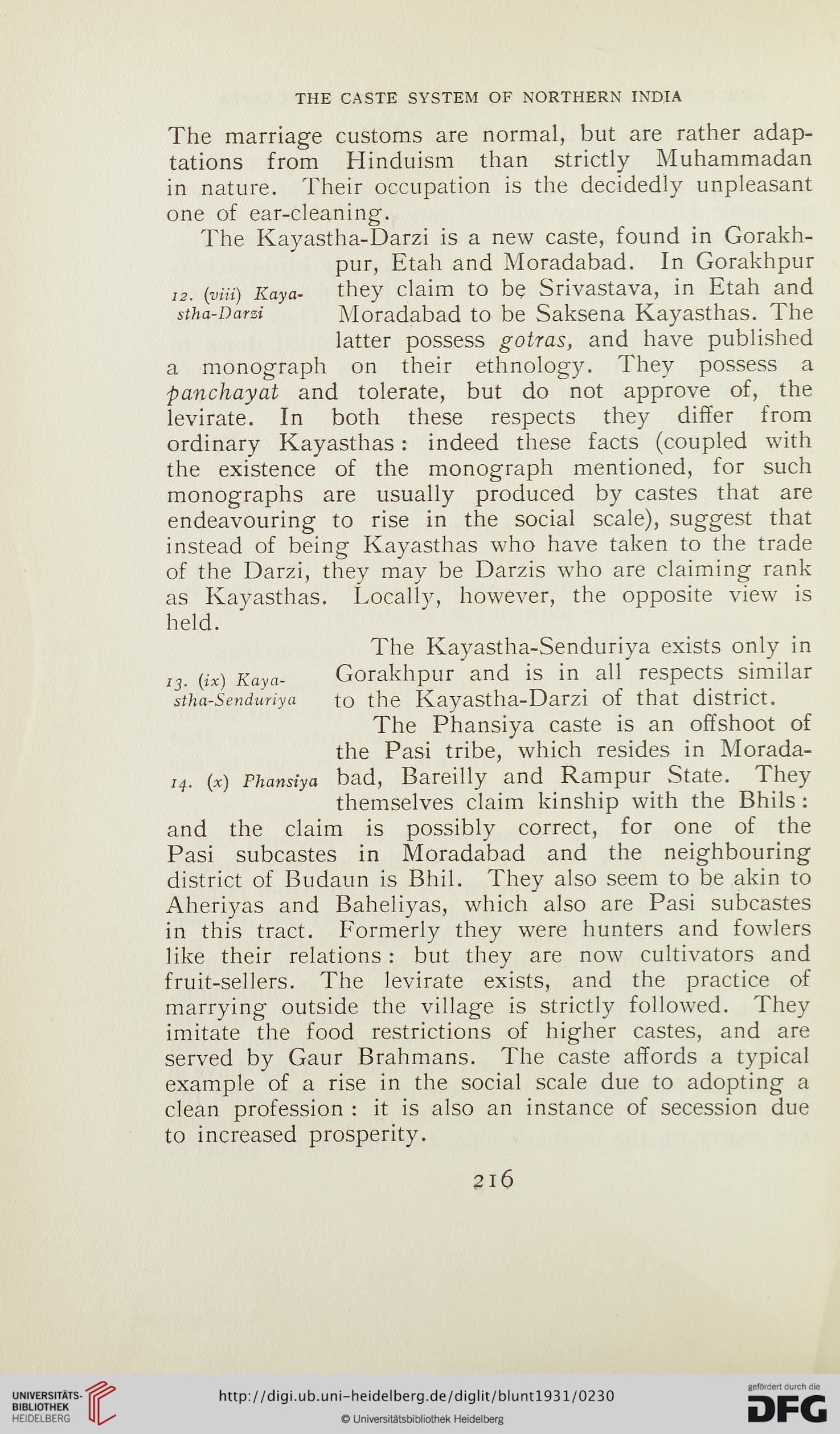THE CASTE SYSTEM OF NORTHERN INDIA
The marriage customs are normal, but are rather adap-
tations from Hinduism than strictly Muhammadan
in nature. Their occupation is the decidedly unpleasant
one of ear-cleaning.
The Kayastha-Darzi is a new caste, found in Gorakh-
pur, Etah and Moradabad. In Gorakhpur
12. (viii) Kaya- they claim to be Srivastava, in Etah and
stha-Darzi Moradabad to be Saksena Kayasthas. The
latter possess gotras, and have published
a monograph on their ethnology. They possess a
panchayat and tolerate, but do not approve of, the
levirate. In both these respects they differ from
ordinary Kayasthas: indeed these facts (coupled with
the existence of the monograph mentioned, for such
monographs are usually produced by castes that are
endeavouring to rise in the social scale), suggest that
instead of being Kayasthas who have taken to the trade
of the Darzi, they may be Darzis who are claiming rank
as Kayasthas. Locally, however, the opposite view is
held.
The Kayastha-Senduriya exists only in
13. (ix) Kaya- Gorakhpur and is in all respects similar
stha-Senduriya to the Kayastha-Darzi of that district.
The Phansiya caste is an offshoot of
the Pasi tribe, which resides in Morada-
14. (x) Phansiya bad, Bareilly and Rampur State. They
themselves claim kinship with the Bhils :
and the claim is possibly correct, for one of the
Pasi subcastes in Moradabad and the neighbouring
district of Budaun is Bhil. They also seem to be akin to
Aheriyas and Baheliyas, which also are Pasi subcastes
in this tract. Formerly they were hunters and fowlers
like their relations: but they are now cultivators and
fruit-sellers. The levirate exists, and the practice of
marrying outside the village is strictly followed. They
imitate the food restrictions of higher castes, and are
served by Gaur Brahmans. The caste affords a typical
example of a rise in the social scale due to adopting a
clean profession : it is also an instance of secession due
to increased prosperity.
216
The marriage customs are normal, but are rather adap-
tations from Hinduism than strictly Muhammadan
in nature. Their occupation is the decidedly unpleasant
one of ear-cleaning.
The Kayastha-Darzi is a new caste, found in Gorakh-
pur, Etah and Moradabad. In Gorakhpur
12. (viii) Kaya- they claim to be Srivastava, in Etah and
stha-Darzi Moradabad to be Saksena Kayasthas. The
latter possess gotras, and have published
a monograph on their ethnology. They possess a
panchayat and tolerate, but do not approve of, the
levirate. In both these respects they differ from
ordinary Kayasthas: indeed these facts (coupled with
the existence of the monograph mentioned, for such
monographs are usually produced by castes that are
endeavouring to rise in the social scale), suggest that
instead of being Kayasthas who have taken to the trade
of the Darzi, they may be Darzis who are claiming rank
as Kayasthas. Locally, however, the opposite view is
held.
The Kayastha-Senduriya exists only in
13. (ix) Kaya- Gorakhpur and is in all respects similar
stha-Senduriya to the Kayastha-Darzi of that district.
The Phansiya caste is an offshoot of
the Pasi tribe, which resides in Morada-
14. (x) Phansiya bad, Bareilly and Rampur State. They
themselves claim kinship with the Bhils :
and the claim is possibly correct, for one of the
Pasi subcastes in Moradabad and the neighbouring
district of Budaun is Bhil. They also seem to be akin to
Aheriyas and Baheliyas, which also are Pasi subcastes
in this tract. Formerly they were hunters and fowlers
like their relations: but they are now cultivators and
fruit-sellers. The levirate exists, and the practice of
marrying outside the village is strictly followed. They
imitate the food restrictions of higher castes, and are
served by Gaur Brahmans. The caste affords a typical
example of a rise in the social scale due to adopting a
clean profession : it is also an instance of secession due
to increased prosperity.
216




